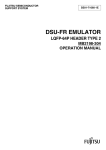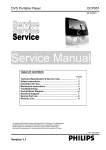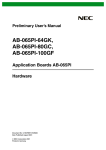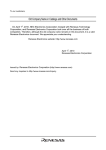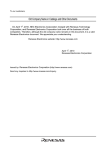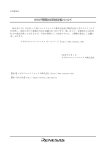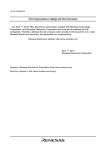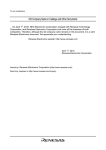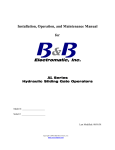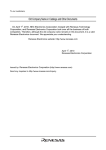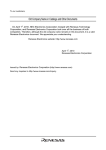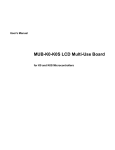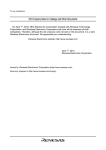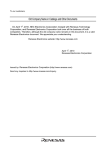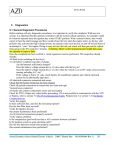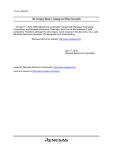Download IE-78K0-NS-P04, IE-780818-NS-EM4 Emulation Board and Probe
Transcript
Preliminary User’s Manual IE-78K0-NS-P04 IE-780818-NS-EM4 Emulation Board and Probe Board for IE-78K0-NS-A Target device µPD780816(A) Subseries Document No. U14514EE2V0UM00 Date Published December 2000 © NEC Corporation 2000 IE-78K0-NS-P04, IE-780818-NS-EM4 This equipment complies with the EMC protection requirements. Warning This is a ´Class A´ (EN 55022: 1994) equipment. This equipment can cause radio frequency noise when used in the residential area. In such cases, the user/operator of the equipment may be required to take appropriate countermeasures under his responsibility. Caution This equipment should be handled like a CMOS semiconductor device. The user must take all precautions to avoid build-up of static electricity while working with this equipment. All test and measurement tools including the workbench must be grounded. The user/operator must be grounded using the wrist strap. The In-Circuit Emulator probe target connector plug and/or its adapter pins should not be touched with bare hands. 2 IE-78K0-NS-P04, IE-780818-NS-EM4 MS-DOS and MS-Windows are either registered trademarks or trademarks of Microsoft Corporation in the United States and/or other countries. PC/AT and PC DOS are trademarks of IBM Corp. The related documents in this publication may include preliminary versions. However, preliminary versions are not marked as such. The export of this product from Japan is regulated by the Japanese government. To export this product may be prohibited without governmental license, the need for which must be judged by the customer. The export or re-export of this product from a country other than Japan may also be prohibited without a license from that country. Please call an NEC sales representative. The information in this document is current as of 24.11.2000. The information is subject to change without notice. For actual design-in, refer to the latest publications of NEC’s data sheets or data books, etc., for the most up-to-date specifications of NEC semiconductor products. Not all products and/or types are available in every country. Please check with an NEC sales representative for availability and additional information. No part of this document may be copied or reproduced in any form or by any means without prior written consent of NEC. NEC assumes no responsibility for any errors that may appear in this document. NEC does not assume any liability for infringement of patents, copyrights or other intellectual property rights of third parties by or arising from the use of NEC semiconductor products listed in this document or any other liability arising from the use of such products. No license, express, implied or otherwise, is granted under any patents, copyrights or other intellectual property rights of NEC or others. Descriptions of circuits, software and other related information in this document are provided for illustrative purposes in semiconductor product operation and application examples. The incorporation of these circuits, software and information in the design of customer’s equipment shall be done under the full responsibility of customer. NEC assumes no responsibility for any losses incurred by customers or third parties arising from the use of these circuits, software and information. While NEC endeavours to enhance the quality, reliability and safety of NEC semiconductor products, customers agree and acknowledge that the possibility of defects thereof cannot be eliminated entirely. To minimize risks of damage to property or injury (including death) to persons arising from defects in NEC semiconductor products, customers must incorporate sufficient safety measures in their design, such as redundancy, fire-containment and anti-failure features. NEC semiconductor products are classified into the following three quality grades: “Standard”, “Special” and “Specific”. The “Specific” quality grade applies only to semiconductor products developed based on a customer-designated “quality assurance program” for a specific application. The recommended applications of a semiconductor product depend on its quality grade, as indicated below. Customers must check the quality grade of each semiconductor product before using it in a particular application. "Standard": Computers, office equipment, communications equipment, test and measurement equipment, audio and visual equipment, home electronic appliances, machine tools, personal electronic equipment and industrial robots. "Special": Transportation equipment (automobiles, trains, ships, etc.), traffic control systems, anti-disaster systems, anti-crime systems, safety equipment and medical equipment (not specifically designed for life support). "Specific": Aircrafts, aerospace equipment, submersible repeaters, nuclear reactor control systems, life support systems or medical equipment for life support, etc. The quality grade of NEC semiconductor products is “Standard“ unless otherwise expressly specified in NEC's data sheets or data books, etc. If customers wish to use NEC semiconductor products in applications not intended by NEC, they must contact an NEC sales representative in advance to determine NEC's willingness to support a given application. Notes: (1) “NEC” as used in this statement means NEC Corporation and also includes its majority-owned subsidiaries. (2) “NEC semiconductor products” means any semiconductor product developed or manufactured by or for NEC (as defined above). M5 2000.03 3 IE-78K0-NS-P04, IE-780818-NS-EM4 Regional Information Some information contained in this document may vary from country to country. Before using any NEC product in your application, please contact the NEC office in your country to obtain a list of authorized representatives and distributors. They will verify: • Device availability • Ordering information • Product release schedule • Availability of related technical literature • Development environment specifications (for example, specifications for third-party tools and components, host computers, power plugs, AC supply voltages, and so forth) • Network requirements In addition, trademarks, registered trademarks, export restrictions, and other legal issues may also vary from country to country. NEC Electronics Inc. (U.S.) NEC Electronics (Germany) GmbH NEC Electronics Hong Kong Ltd. Santa Clara, California Tel: 800-366-9782 Fax: 800-729-9288 Benelux Office Eindhoven, The Netherlands Tel: 040-2445845 Fax: 040-2444580 Hong Kong Tel: 2886-9318 Fax: 2886-9022/9044 NEC Electronics (Germany) GmbH Duesseldorf, Germany Tel: 0211-65 03 02 Fax: 0211-65 03 490 NEC Electronics Hong Kong Ltd. Velizy-Villacoublay, France Tel: 01-30-67 58 00 Fax: 01-30-67 58 99 Seoul Branch Seoul, Korea Tel: 02-528-0303 Fax: 02-528-4411 NEC Electronics (France) S.A. NEC Electronics Singapore Pte. Ltd. Spain Office Madrid, Spain Tel: 01-504-2787 Fax: 01-504-2860 United Square, Singapore 1130 Tel: 253-8311 Fax: 250-3583 NEC Electronics (France) S.A. NEC Electronics (UK) Ltd. Milton Keynes, UK Tel: 01908-691-133 Fax: 01908-670-290 NEC Electronics Italiana s.r.l. Milano, Italy Tel: 02-66 75 41 Fax: 02-66 75 42 99 NEC Electronics Taiwan Ltd. NEC Electronics (Germany) GmbH Scandinavia Office Taeby, Sweden Tel: 08-63 80 820 Fax: 08-63 80 388 Taipei, Taiwan Tel: 02-719-2377 Fax: 02-719-5951 NEC do Brasil S.A. Sao Paulo-SP, Brasil Tel: 011-889-1680 Fax: 011-889-1689 4 IE-78K0-NS-P04, IE-780818-NS-EM4 Introduction Product Overview The IE-78K0-NS-P04 and the IE-780818-NS-EM4, when combined with the IE-78K0-NS-A, are used to debug the following target devices that belong to the 78K/0 Series of 8-bit single-chip microcontrollers. • µPD780816(A) Subseries Target Readers This manual is intended for engineers who will use the IE-78K0-NS-P04 and the IE-780818-NS-EM4 with the IE-78K0-NS-A to perform system debugging. Engineers who use this manual are expected to be thoroughly familiar with the target device’s functions and use methods and to be knowledgeable about debugging. Organization When using the IE-78K0-NS-P04 and the IE-780818-NS-EM4, refer to not only this manual (supplied with the IE-780818-NS-EM4) but also the manual that is supplied with the IE-78K0-NS-A. IE-78K0-NS-A User's Manual · · · · Purpose Basic specifications System configuration Part names External interface functions IE-78K0-NS-P04 IE-780818-NS-EM4 User's Manual · General · Parts names · Installation · Differences between target devices and target interface circuits This manual’s purpose is to explain various debugging functions that can be performed when using the IE-78K0-NS-P04 and the IE-780818-NS-EM4. 5 IE-78K0-NS-P04, IE-780818-NS-EM4 Terminology The meanings of certain terms used in this manual are listed below. Meaning Term Emulation device Emulation CPU Target device Target system This is a general term that refers to the device in the emulator that is used to emulate the target device. It includes the emulation CPU. This is the CPU block in the emulator that is used to execute usergenerated programs. This is a device (a µPD780816(A) Subseries chip) that is the target for emulation. This includes the target program and the hardware provided by the user. W hen defined narrowly, it includes only the hardware. This refers to the combination of the IE-78K0-NS-A, IE system Conventions the IE-78K0-NS-P04 and the IE-780818-NS-EM4. Data significance weight : Higher digits on the left and lower digits on the right Note : Footnote for item marked with Note in the text. Caution : Information requiring particular attention Remark : Supplementary information Related Documents The related documents indicated in this publication may include preliminary versions. However, preliminary versions are not marked as such. Document Number Document Name English IE-78K0-NS-A To be prepared IE-78K0-NS-P04, IE-780818-NS-EM4 ID78K0-NS Integrated Debugger Reference Windows TM Based Japanese To be prepared This manual To be prepared U12900E U12900J Caution: The documents listed above are subject to change without notice. Be sure to use the latest documents when designing. 6 IE-78K0-NS-P04, IE-780818-NS-EM4 Table of Contents Introduction ................................................................................................................................................... 5 Chapter 1 General ....................................................................................................................................... 11 1.1 1.2 1.3 1.4 System Configuration .......................................................................................................................... Hardware Configuration ....................................................................................................................... Basic Specifications ............................................................................................................................. Notes on Use of IE-78K0-NS-P04 and IE-780818-NS-EM4 ................................................................. 12 14 15 16 Chapter 2 Part Names ................................................................................................................................ 17 2.1 Package Components ........................................................................................................................... 17 2.2 Parts of the IE-78K0-NS-P04 ................................................................................................................ 18 2.3 Parts of the IE-780818-NS-EM4 ............................................................................................................ 19 Chapter 3 Installation .................................................................................................................................. 21 3.1 Installation Procedure ........................................................................................................................... 3.2 Clock Settings ....................................................................................................................................... 3.2.1 Overview of clock settings ............................................................................................................. 3.2.2 Main System Clock Selections ...................................................................................................... 3.2.3 Subsystem Clock Selections ......................................................................................................... 3.2.4 Main System Clock Settings .......................................................................................................... 3.2.5 Examples of Main System Clock Setting ...................................................................................... 3.3 Subsystem Clock ................................................................................................................................... 3.3.1 Subsystem Clock Setting ............................................................................................................... 3.3.2 Examples of Subsystem Clock Setting ......................................................................................... 3.4 Jumper Settings .................................................................................................................................... 3.5 External Trigger ..................................................................................................................................... 22 30 30 31 32 34 39 40 40 45 46 47 Chapter 4 Differences among Target Devices and Target Interface Circuits .......................................... 49 4.1 Input/Output Signals ............................................................................................................................. 4.2 Differences in Port Functions ............................................................................................................... 4.3 Differences in SFR-Registers ............................................................................................................... 4.4 Target Interface Circuit .......................................................................................................................... 50 54 54 54 Chapter 5 Restrictions ............................................................................................................................... 55 Appendix A IE-78K0-NS-P04, IE-780818-NS-EM4 Product Specifications .............................................. 57 Appendix B Conversion Socket Adapter Package Drawings and recommended Board Mounting Pattern .......................................................................................................... 59 Appendix C Pin Correspondence Tables of Emulation Probe ................................................................. 61 7 IE-78K0-NS-P04, IE-780818-NS-EM4 List of Figures Figure 1-1: System Configuration ............................................................................................................. 12 Figure 1-2: Basic Hardware Configuration ............................................................................................... 14 Figure 2-1: IE-78K0-NS-P04 External View and Part Names .................................................................... 18 Figure 2-2: IE-780818-NS-EM4 External View and Part Names ................................................................ 19 Figure 3-1: IE-78K0-NS-A inside ................................................................................................................. 22 Figure 3-2: Main Board (G-780009) Jumper Positioning ........................................................................... 23 Figure 3-3: Emulation Board (IE-78K0-NS-P04) Jumper Positioning ....................................................... 25 Figure 3-4: Emulation Board (IE-780818-NS-EM4) Jumper Positioning ................................................... 28 Figure 3-5: External Circuits Used as System Clock Oscillation Circuit ................................................ 30 Figure 3-6: When Using Clock That Is Already Mounted on Emulation Board ....................................... 31 Figure 3-7: When Using User-mounted Clock .......................................................................................... 31 Figure 3-8: When Using an External Clock ............................................................................................... 32 Figure 3-9: When Using Standard Clock Mounted on Main Board .......................................................... 32 Figure 3-10: When Using Clock Mounted on the Emulation Board ......................................................... 33 Figure 3-11: Using an External Clock mounted on the Target Hardware ............................................. 33 Figure 3-12: Connections on Parts Board (When Using Main System Clock or User-Mounted Clock) 35 Figure 3-13: IE-78K0-NS-A side (Emulation Device) ................................................................................ 36 Figure 3-14: Crystal Oscillator (When Using Main System Clock or User-mounted Clock) .................. 37 Figure 3-15: Pin Alignment of Crystal Oscillator and Socket .................................................................. 37 Figure 3-16: IE-78K0-NS-A side (Emulation Device) ................................................................................ 38 Figure 3-17: Connections on Parts Board (When Using Subsystem Clock or User-Mounted Clock) .. 41 Figure 3-18: IE-78K0-NS-A side ................................................................................................................. 42 Figure 3-19: Crystal Oscillator (When Using Subsystem Clock or User-mounted Clock) .................... 43 Figure 3-20: IE-78K0-NS-A side ................................................................................................................. 44 Figure 3-21: IE-78K0-NS-A side ................................................................................................................. 44 Figure 3-22: External Trigger Input Position ............................................................................................. 47 Figure 4-1: Equivalent Circuit 1 from Emulation Circuit .......................................................................... 51 Figure 4-2: Equivalent Circuit 2 from Emulation Circuit .......................................................................... 52 Figure 4-3: Equivalent Circuit 3 from Emulation Circuit .......................................................................... 53 Figure 5-1: Clock Monitor Implementation ............................................................................................... 55 8 IE-78K0-NS-P04, IE-780818-NS-EM4 List of Tables Table 1-1: Basic Specifications .................................................................................................................. 15 Table 2-1: Names of IE-78K0-NS-P04 and IE-780818-NS-EM4 Parts ........................................................ 20 Table 3-1: Flash ROM Mode ........................................................................................................................ Table 3-2: Internal Mode 1 ........................................................................................................................... Table 3-3: Internal Mode 2 ........................................................................................................................... Table 3-4: Main Clock Selection .................................................................................................................. Table 3-5: Main Clock Doubler Selection ................................................................................................... Table 3-6: Sub Clock Selection ................................................................................................................... Table 3-7: Reference Voltage Pin of AD-Converter ................................................................................... Table 3-8: Ground Voltage Pin of AD-Converter ....................................................................................... Table 3-9: JTAG Mode ................................................................................................................................. Table 3-10: JTAG Mode ............................................................................................................................... Table 3-11: FPGA Mode Selection ............................................................................................................. Table 3-12: JTAG Mode ............................................................................................................................... Table 3-13: Reference Voltage Setting ....................................................................................................... Table 3-14: Reference Voltage Setting ....................................................................................................... Table 3-15: Future Function ....................................................................................................................... Table 3-16: LED Indicator D1, D2, D3 ......................................................................................................... Table 3-17: User RESET mode ................................................................................................................... Table 3-18: DCAN Out Transmit Buffer Selection ..................................................................................... Table 3-19: DCAN in Buffer Type Selection ............................................................................................... Table 3-20: Main System Clock Settings ................................................................................................... Table 3-21: Subsystem Clock Settings ...................................................................................................... Table 3-22: Jumper Settings on IE-78K0-NS-A ......................................................................................... Table 3-23: Jumper Settings on IE-78K0-NS-P04...................................................................................... Table 3-24: Jumper Settings on IE-780818-NS-EM4 ................................................................................. 23 23 24 24 24 24 25 25 26 26 26 26 26 26 27 27 29 29 29 40 40 46 46 46 Table 5-1: Difference between the Conversion Time ................................................................................ 55 Table C-1: Connector CN11 to Emulation Probe (1/2) .............................................................................. 61 Table C-1: Connector CN11 to Emulation Probe (2/2) .............................................................................. 62 9 IE-78K0-NS-P04, IE-780818-NS-EM4 [MEMO] 10 IE-78K0-NS-P04, IE-780818-NS-EM4 Chapter 1 General The IE-78K0-NS-P04 and the IE-780818-NS-EM4 are development tools for efficient debugging of hardware or software when using one of the following target devices that belong to the 78K/0 Series of 8-bit single-chip microcontrollers. This chapter describes the emulation board’s and probe board's system configuration and basic specifications. - Target device - µPD780816(A) Subseries 11 IE-78K0-NS-P04, IE-780818-NS-EM4 1.1 System Configuration Figure 1-1 illustrates the IE-78K0-NS-P04 / IE-780818-NS-EM4’s system configuration. Figure 1-1: System Configuration Debugger ID78K0-NS Device file Control software Host machine PC-9800 Series or IBM PC/AT™ compatibles Interface board IE-70000-PCI-IF-A Interface board IE-70000-98-IF-C Interface board IE-70000-PC-IF-C Interface card or or Interface cable (NS IF Cable) IE-78K0-NS-A Interface cable In-circuit emulator NS CARD Cable MC CARD Cable IE-70000-CD-IF-A FG Cable IE-78K0-NS-P04 IE-780818-NS-EM4 AC adapter Emulation probe Conversion socket/conversion adapter 12 IE-78K0-NS-P04, IE-780818-NS-EM4 Note: The packages, emulation probes, and conversion sockets/conversion adapters are listed below. Package Emulation Probe Conversion Socket/ Conversion Adapter NQPACK064SB 64-pin plastic QFP (GK - type) NP-64GK YQPACK064SB HQPACK064SB140 YQSOCKET064SBF The NP-64GK is a product of Naito Densei Machidaseisakusho Co., Ltd. The sockets are products of TOKYO ELETECH CORPORATION. 13 IE-78K0-NS-P04, IE-780818-NS-EM4 1.2 Hardware Configuration Figure 1-2 shows the IE-78K0-NS-P04/IE-780818-NS-EM4’s position in the basic hardware configuration. Figure 1-2: Basic Hardware Configuration Dedicated bus interface IE system IE-78K0-NS-A Host machine Interface board) 78K0 Emulator IE-78K0-NS-P04 IE-780818-NS-EM4 Emulation board (This product) Interface card Emulation probe NP-64GK 14 IE-78K0-NS-P04, IE-780818-NS-EM4 1.3 Basic Specifications The IE-78K0-NS-P04/IE-780818-NS-EM4’s basic specifications are listed in Table 1-1. Table 1-1: Basic Specifications Parameter Target device System clock Clock supply Voltage support Description µPD780816(A) Subseries Main system clock: 8.38 MHz Subsystem clock: typical. 32.768 KHz External: Pulse input Internal: Mounted on emulation board 4.0 to 5.5 V (same as target device) 15 IE-78K0-NS-P04, IE-780818-NS-EM4 1.4 Notes on Use of IE-78K0-NS-P04 and IE-780818-NS-EM4 (1) Ensure that the power supply for the IE-78K0-NS-A and the target system is OFF before connecting or disconnecting to/from the IE-78K0-NS-A and the target device, or changing switch settings, etc. (2) When carrying out target device emulation using the IE-78K0-NS-P04 and IE-780818-NS-EM4 in conjunction with the IE-78K0-NS-A, there are certain differences from the operation of the actual device (see Differences from Target Device). (3) The target system VDD must be between 4.0 V and 5.5 V. (4) Power on sequence: 1. Power on IE-78K0-NS-A 2. Power on target hardware 3. Start debugger ID78K0-NS (5) Power off sequence: 1. Exit from debugger ID78K0-NS 2. Power off target hardware 3. Power off IE-78K0-NS-A. 16 IE-78K0-NS-P04, IE-780818-NS-EM4 Chapter 2 Part Names This chapter introduces the parts of the IE-78K0-NS-P04 and the IE-780818-NS-EM4. The packaging boxes of the IE-78K0-NS-P04 and the IE-780818-NS-EM4 contain the following items: 2.1 Package Components IE-78K0-NS-P04 Components The IE-78K0-NS-P04 comprises the following components. Please check that all these items are included in the package. (1) (2) (3) (4) (5) IE-78K0-NS-P04 Parts holder (with cover) Registration Card Readme First List of Contents x x x x x 1 2 1 1 1 IE-780818-NS-EM4 Components The IE-780818-NS-EM4 comprises the following components. Please check that all these items are included in the package. (1) (2) (3) (4) (5) (6) IE-780818-NS-EM4 Screws Set Registration Card Readme First List of Contents Floppy Disk with Device File and FPGA Data (7) User's Manual (this manual) x x x x x 1 1 1 1 1 x1 x1 17 IE-78K0-NS-P04, IE-780818-NS-EM4 2.2 Parts of the IE-78K0-NS-P04 Figure 2-1: IE-78K0-NS-P04 External View and Part Names Main system clock (fix 8.00 MHz) Subsystem clock (user defined) 18 Main system clock (user defined) IE-78K0-NS-P04, IE-780818-NS-EM4 2.3 Parts of the IE-780818-NS-EM4 Figure 2-2: IE-780818-NS-EM4 External View and Part Names External Trigger EXT OUT EXT IN Emulation probe connector CN11 User VDD LED 19 IE-78K0-NS-P04, IE-780818-NS-EM4 Table 2-1: Names of IE-78K0-NS-P04 and IE-780818-NS-EM4 Parts Name Description (IE-78K0-NS-P04) CN1 CN2 CN3 Emulator connections Emulation board connectors CN6 (IE-78K0-NS-P04) CN7 CN8 CN5 CN9 CN6 CN10 CN8 Probe board connectors (IE-78K0-NS-P04) Description (IE-780818-NS-EM4) CN5 CN4 CN7 CN11 Probe connector JP1 Disconnect USER-Reset CN9 JP2 CAN TxD driver buffer type CN10 JP3 CAN RxD receive buffer type CN11 CN12 CN13 CN14 CN15 Test connector (only for internal use by NEC) CN16 CN17 CN18 JP1 Analog reference voltage JP2 JP7 GND-pin of A/D Converter Reseved (only for internal use by NEC) JTAG mode selection (only for internal use by NEC) FPGA mode selection JTAG mode selection (only for internal use by NEC) LVREF1 JP8 LVREF0 JP3 JP4 JP5 JP6 20 Name IE-78K0-NS-P04, IE-780818-NS-EM4 Chapter 3 Installation This chapter describes the method for the connection of the IE-78K0-NS-P04, the IE-780818-NS-EM4 and the emulation probe. - Installation of the IE-78K0-NS-P04 Installation of the IE-780818-NS-EM4 Installation of the emulation probe Setting of the jumpers for the clock selection The power supply of the IE-78K0-NS-A and the target system must be switched off when connecting or disconnecting any item. Caution: Usage of incorrect connection methods may damage the IE system. 21 IE-78K0-NS-P04, IE-780818-NS-EM4 3.1 Installation Procedure <1> Remove the 4 screws at the sides of the IE-78K0-NS-A and open the top of the cover. <2> Remove the screws on the option board (G-78K0H) and remove the option board. Figure 3-1: IE-78K0-NS-A inside Option Board (G-78K0H) Main board (G-780009) <3> Setup the jumper’s on the main board (G-780009). It is necessary to set some jumpers on the main board for the clock selection. An example for the jumper setting will be given in the chapter clock setting. 22 IE-78K0-NS-P04, IE-780818-NS-EM4 Figure 3-2: Main Board (G-780009) Jumper Positioning JP7 JP8 JP6 JP4 JP3 JP2 Jumper JP2 Table 3-1: Flash ROM Mode Jumper Position Function (1-2) Internal use (2-3) Internal use (default) Jumper JP3 Table 3-2: Internal Mode 1 Jumper Position Function (1-2) Internal use (default) (2-3) Internal use 23 IE-78K0-NS-P04, IE-780818-NS-EM4 Jumper JP4 Table 3-3: Internal Mode 2 Jumper Position Function (1-2) Internal use (default) (2-3) Internal use Jumper JP6 Table 3-4: Main Clock Selection Jumper Position Function (1-2) Not selectable (3-4) EM1/P04 board selection (default) (5-6) EM4 board selection Jumper JP7 Table 3-5: Main Clock Doubler Selection Jumper Position Function (1-2) Main board selection (default) (3-4) EM board selection 1 (5-6) EM board selection 2 Jumper JP8 Table 3-6: Sub Clock Selection Jumper Position Function (1-2) On EM board (default) (3-4) On target system (5-6) On main board <4> Connect the option board (G-78K0H) to the main board (G-780009). <5> Setup of the emulation board (IE-78K0-NS-P04) 24 IE-78K0-NS-P04, IE-780818-NS-EM4 Figure 3-3: Emulation Board (IE-78K0-NS-P04) Jumper Positioning JP1 JP2 JP7 JP8 NEC IE-78K0-NS-P04 JP9 JP5 JP4 SO1 JP3 JP6 Jumper JP1 Table 3-7: Reference Voltage Pin of AD-Converter Jumper Position AAVREF Function Open Target Connected to target selected reference voltage (default) Close GND Reference voltage Remark: Close jumper JP1 when the AD-converter is not used. Jumper JP2 Table 3-8: Ground Voltage Pin of AD-Converter Jumper Position AAVSS Function Open Target Connected to target selected ground base (default) Close GND Internal digital ground Remark: Close jumper JP2 when the AD-converter is not used. 25 IE-78K0-NS-P04, IE-780818-NS-EM4 Jumper JP3 Table 3-9: JTAG Mode Jumper Position JTAG Function Open Pull-up Reserved (Internal use) (default) Close GND Reserved (Internal use) Jumper JP4 Table 3-10: JTAG Mode Jumper Position JTAG Open Pull-up Close GND Function Reserved (Internal use) Reserved (Internal use) (default) Jumper JP5 Table 3-11: FPGA Mode Selection Jumper Position ESN Open Pull-up Close GND Function Asynchronous peripheral mode (FPGA s are loaded by IE) (default) Reserved (Internal use) Jumper JP6 Table 3-12: JTAG Mode Jumper Position JTAG Function (1-2) Pull-up Reserved (Internal use) (2-3) GND Reserved (Internal use) (default) Jumper JP7 Table 3-13: Reference Voltage Setting 26 Jumper Position LVREF1 (1-2) VCC Function Reserved (Internal use) (default) (2-3) LVDD Reserved (Internal use) IE-78K0-NS-P04, IE-780818-NS-EM4 Jumper JP8 Table 3-14: Reference Voltage Setting Jumper Position LVREF0 (1-2) VCC Function Reserved (Internal use) (default) (2-3) LVDD Reserved (Internal use) Jumper JP9 Table 3-15: Future Function Jumper Position Function Open Pull-up Close GND Reserved (Internal use) (default) Reserved (Internal use) LED Indicator Table 3-16: LED Indicator D1, D2, D3 LED Condition Function LED1 green Blinking FPGA download ongoing LED1 green On FPGA download complete LED1 green Off FPGA not programmed LED2 yellow Blinking Not used LED2 yellow On VCC on LED2 yellow Off VCC off LED3 red Blinking Not used LED3 red On Not used LED3 red Off Not used Remark: Not used LED's are reserved for future functions. 27 IE-78K0-NS-P04, IE-780818-NS-EM4 <6> Connect the emulation board (IE-78K0-NS-P04) to the option board (G-78K0H). <7> When user clock as main clock is used, the main system clock can be mounted by using a parts holder or a crystal oscillator (see chapter clock setting). <8> Setup of the probe board (IE-780818-NS-EM4) NEC IE-780818-NS-EM4 Figure 3-4: Emulation Board (IE-780818-NS-EM4) Jumper Positioning JP1 28 JP2 JP3 IE-78K0-NS-P04, IE-780818-NS-EM4 Jumper JP1 Table 3-17: User RESET mode Jumper Position (1-2) User RESET To probe (2-3) Pull-up Function User Reset (IE) connected to the probe (default) User Reset (IE) pull-up by resistor (10K) Jumper JP2 Table 3-18: DCAN Out Transmit Buffer Selection Jumper Position DCAN out Function (1-2) Pin emulator (2-3) FPGA Reserved DCAN transmit line from FPGA via transistor to probe (default) Jumper JP3 Table 3-19: DCAN in Buffer Type Selection Jumper Position (1-2) Pin emulator (2-3) FPGA DCAN in Function Original buffer (default) Buffer type different /timing optimized (limitation USRV DD ≥ 4.5 V) 29 IE-78K0-NS-P04, IE-780818-NS-EM4 3.2 Clock Settings 3.2.1 Overview of clock settings Main system clock Select from (1) to (3) below as the main system clock and subsystem clock to be used during debugging. (1) Clock that is already mounted on emulation board (2) Clock that is mounted by user (3) External clock If the target system includes an internal clock, select either “(1) Clock that is already mounted on emulation board” or “(2) Clock that is mounted by user”. An internal clock connects the target device to an oscillator and uses the target device’s internal oscillation circuit. An example of an external circuit is shown in part (a) of Figure 3-5. During emulation, the oscillator that is mounted on the target system is not used. Instead, it uses the clock that is mounted on the emulation board which is installed for the IE-78K0-NS-A. If the target system includes an external clock, select “(3) External clock”. An external clock supplies a clock signal from outside of the target device and does not use the target device’s internal oscillation circuit. An example of an external circuit is shown in part (b) of Figure 3-5. Figure 3-5: External Circuits Used as System Clock Oscillation Circuit Target device X1 or CL1 X2 or CL2 30 Target device External clock X1 or CL1 X2 or CL2 IE-78K0-NS-P04, IE-780818-NS-EM4 3.2.2 Main System Clock Selections (1) Clock that is already mounted on emulation board A crystal resonator is already mounted on the emulation board. Its frequency is 8.0000 MHz. Figure 3-6: When Using Clock That Is Already Mounted on Emulation Board IE-78K0-NS-A Target system IE-78K0-NS-P04 Mounted oscillator (to be used) Emulation probe Oscillator (not used) Remark: The clock that is supplied by the IE-78K0-NS-P04 oscillator (encircled in the figure) is used. (2) Clock that is mounted by user The user is able to mount any clock supported by the set specifications on the IE-78K0-NS-P04. First mount the oscillator on the parts holder, then attach the parts board to the IE-78K0-NS-P04. This method is useful when using a different frequency from that of the pre-mounted clock. Figure 3-7: When Using User-mounted Clock IE-78K0-NS-A IE-78K0-NS-P04 Parts board Oscillator (to be used) Remark: Target system Emulation probe Oscillator (not used) The clock that is supplied by the IE-78K0-NS-P04 oscillator (encircled in the figure) is used. 31 IE-78K0-NS-P04, IE-780818-NS-EM4 (3) External clock An external clock connected to the target system can be used via the emulation probe. Figure 3-8: When Using an External Clock IE-78K0-NS-A Target system Emulation probe Clock generator (to be used) Remark: The clock supplied by the target system’s clock generator (encircled in the figure) is used. 3.2.3 Subsystem Clock Selections (1) Standard clock offered by the main board A crystal oscillator is already mounted on the main board. The frequency is 32.768 kHz. Figure 3-9: When Using Standard Clock Mounted on Main Board IE-78K0-NS-A Target System IE-78K0-NS-P04 Emulation Probe Clock Oscillator Resonator (not used) Remark: 32 The clock supplied from the oscillator on the Main Board (G-78009) (circled) is used. IE-78K0-NS-P04, IE-780818-NS-EM4 (2) Clock mounted by user on the emulation board A clock that matches the specifications set by the user can be mounted on the IE-78K0-NS-P04. The resonator or oscillator to be used is mounted on a parts holder and that parts holder is installed on the IE-78K0-NS-P04. This is useful if you want to perform debugging at a different frequency from that of the clock mounted beforehand. Figure 3-10: When Using Clock Mounted on the Emulation Board IE-78K0-NS-A IE-78K0-NS-P04 Parts Holder Target System Emulation Probe Resonator or Oscillator (used) Remark: Resonator (not used) The clock supplied from the resonator or oscillator on the IE-78K0-NS-P04 (circled) is used. (3) External clock on the target hardware The external clock on the target system can be used via an emulation probe. Figure 3-11: Using an External Clock mounted on the Target Hardware IE-78K0-NS-A Target system Emulation probe Clock generator (to be used) Remark: The clock supplied by the clock generator circuit (circled in the above figure) is used. 33 IE-78K0-NS-P04, IE-780818-NS-EM4 3.2.4 Main system clock settings Table 3-20: Main System Clock Settings Frequency of Main System Clock When using clock that is already mounted on emulation board When using clock mounted by user When using external clock 8.00 MHz IE-78K0-NS-P04 Shortcut 6-8 CPU Clock Source Selection (ID) Internal Includes oscillator circuit Other than 8.00 MHz External Shortcut 6-8 Caution: When using an an user defined clock or external clock, open the configuration dialog when starting the integrated debugger (ID78K0-NS) and select “External” in the area (Clock) for selecting the CPU’s clock source (this selects the user’s clock). Remark: The IE-78K0-NS-P04 factory settings are those listed above under “when using clock that is already mounted on emulation board”. (1) When using clock that is already mounted on emulation board When the IE-78K0-NS-P04 is shipped, an 8.00-MHz crystal resonator is already mounted in the IE78K0-NS-P04 X4 socket. When using the factory-set mode settings, there is no need to make any other hardware settings. When starting the integrated debugger (ID78K0-NS), open the configuration dialog and select “Internal” in the area (Clock) for selecting the CPU’s clock source (this selects the emulator’s internal clock). 34 IE-78K0-NS-P04, IE-780818-NS-EM4 (2) When using clock mounted by user The settings described under either (a) or (b) are required, depending on the type of clock to be used. When starting the integrated debugger (ID78K0-NS), open the configuration dialog and select “External” in the area (Clock) for selecting the CPU’s clock source (this selects the emulator’s internal clock). (a) When using a ceramic oscillator or crystal resonator - Items to be prepared - Parts holder (supplied with IE-78K0-NS-P04) - Ceramic oscillator or crystal resonator - Resistor Rx · Capacitor CA · Capacitor CB · Solder kit <Steps> <1> Solder onto the supplied parts board (as shown below) the target ceramic oscillator or crystal resonator, resistor Rx, capacitor CA, and capacitor CB (all with suitable oscillation frequency). Figure 3-12: Connections on Parts Board (When Using Main System Clock or User-Mounted Clock) Parts holder 7 14 Pin No. 6 13 2-13 Capacitor CB 5 12 3-12 Capacitor CA 4 11 4-11 Ceramic oscillator or crystal resonator 3 10 5-10 Resistor Rx 2 9 8-9 Short 1 8 Connection Circuit diagram 10 MΩ HCU04 HCU04 Clock Out 5 Rx 10 4 11 13 3 CA CB 12 Remark: 98 2 The sections enclosed in broken lines indicate parts that are attached to the parts board. 35 IE-78K0-NS-P04, IE-780818-NS-EM4 <2> Prepare the IE-78K0-NS-P04. <3> Remove the parts holder inserted in the socket (marked "X2") on the IE-78K0-NS-P04. <4> Connect the parts holder (from <1> above) to the socket (X2) from which the part holder was removed. Check the pin 1 mark to make sure the board is mounted in the correct direction. <5> Make sure that the parts board mounted in the X2 socket on the emulation board is wired as shown in Figure 3-10 above. <6> Install the IE-78K0-NS-P04 and the IE-780818-NS-EM4 in the IE-78K0-NS-A. The above steps configure a circuit and enable clock output to be supplied from the mounted oscillator to the emulation device. Figure 3-13: IE-78K0-NS-A side (Emulation Device) IE-78K0-NS-A side (Emulation device) 10 MΩ HCU04 6 HCU04 9 X1 8 5 A B Rx X 4 Y 10 VHC157 11 13 3 CB CA X1 12 2 Remark: 36 The sections enclosed in broken lines indicate parts that are attached to the parts holder. IE-78K0-NS-P04, IE-780818-NS-EM4 (b) When using a crystal oscillator - Items to be prepared - Crystal oscillator (see pinouts shown in Figure 3-15) Figure 3-14: Crystal Oscillator (When Using Main System Clock or User-mounted Clock) Vcc NC Clock Out GND <Steps> <1> Prepare the IE-78K0-NS-P04. <2> Remove the parts holder inserted in the socket (marked “X2”) on the IE-78K0-NS-P04. <3> Connect the parts board (from <2> above) to the socket (X2) from which the parts holder was removed. Insert the crystal oscillator into the socket so as to align the pins as shown in the figure below. Figure 3-15: Pin Alignment of Crystal Oscillator and Socket Crystal oscillator NC GND Socket VCC CLOCK OUT Crystal Oscillator Pin Name Socket Pin No. 13 NC 1 12 GND 7 CLOCK OUT 8 VCC 14 1 14 2 3 4 11 5 10 6 9 7 8 <4> Install the IE-78K0-NS-P04 and the IE-780818-NS-EM4 in the IE-78K0-NS-A. 37 IE-78K0-NS-P04, IE-780818-NS-EM4 The above steps configure a circuit and enable clock output to be supplied from the mounted oscillator to the emulation device. Figure 3-16: IE-78K0-NS-A side (Emulation Device) VCC IE-78K0-NS-A side (Emulation device) Crystal oscillator X1 A Y B VHC157 (3) When using an external clock No hardware settings are required for this situation. Make sure that the parts holder with a shortcut between 6 and 8 is in the socket (marked "X2"). When starting the integrated debugger (ID78K0-NS), open the configuration dialog and select “External” in the area (Clock) for selecting the CPU’s clock source (this selects the user’s clock). 38 IE-78K0-NS-P04, IE-780818-NS-EM4 3.2.5 Examples of Main System Clock Setting (1) Standard Clock 8.00 MHz offered by the Emulation Board (IE-78K0-NS-P04) Main Board: JP6 - (3-4) JP7 - (1-2) Emulation Board: X2 with shortcut between 6 - 8 ID78K0-NS: Internal (2) Clock mounted by the User on the Emulation Board - User related Clock Main Board: JP6 - (3-4) JP7 - (1-2) Emulation Board: X2 with parts holder and crystal resonator, ceramic resonator or crystal oscillator ID78K0-NS: External (3) External Clock on the Target Hardware Main Board: JP6 - (3-4) JP7 - (1-2) Emulation Board: X2 with shortcut between 6 - 8 ID78K0-NS: External 39 IE-78K0-NS-P04, IE-780818-NS-EM4 3.3 Subsystem Clock 3.3.1 Subsystem Clock Setting Table 3-21: Subsystem Clock Settings Subsystem Clock Frequency to be Used When using clock that is already mounted on main board When using usermounted clock When using external clock 32.768 KHz IE-78K0-NS-P04 IE-78K0-NS-A Parts holder (X1) JP8 Short 6 - 8 Short 5 - 6 Includes oscillator Short 1 - 2 Not used Short 3 - 4 Other than 32.768 KHz Caution: Jumper JP8, which is used to select the board’s clock or an external clock, should be set only after turning off the IE-78K0-NS-A’s power. (1) When using clock that is already mounted on main board When the IE-78K0-NS-P04 / IE-780818-NS-EM4 are shipped, there is no 32.768 KHz crystal on the board. The parts holder on X1 is shortened between 6 and 8. Short pins 5 and 6 of the IE-78K0-NSA's main board to use the 32.768 KHz crystal of the emulator. There is no additional settings of the integrated debugger ID78K0-NS necessary. (2) When using the user-mounted clock on the IE-78K0-NS-P04 The settings described under either (a) or (b) are required, depending on the type of clock to be used. Short pins 1 and 2 on the IE-78K0-NS-A’s jumper (JP8). There is no need to make any other settings via the integrated debugger (ID78K0-NS). (a) When using a ceramic oscillator or crystal resonator - Items to be prepared - Parts board (supplied with IE-78K0-NS) - Ceramic oscillator or crystal resonator - Resistor Rx - Capacitor CA - Capacitor CB - Solder kit <Steps> <1> Solder onto the supplied parts board (as shown below) the target ceramic oscillator or crystal resonator, resistor Rx, capacitor CA, and capacitor CB (all with suitable oscillation frequency). 40 IE-78K0-NS-P04, IE-780818-NS-EM4 Figure 3-17: Connections on Parts Board (When Using Subsystem Clock or User-Mounted Clock) Parts holder (X1 of IE-78K0-NS-P04) 1 14 Pin No. 2 13 2-13 Capacitor CB 3 12 3-12 Capacitor CA 4 11 10 4-11 Ceramic oscillator or crystal resonator 5 6 9 5-10 Resistor Rx 7 8 8-9 Short Connection Circuit diagram 10 MΩ HCU04 HCU04 5 Rx 10 4 3 CA 12 Remark: 98 CLOCK OUT 11 13 CB 2 The sections enclosed in broken lines indicate parts that are attached to the parts board. 41 IE-78K0-NS-P04, IE-780818-NS-EM4 <2> Prepare the IE-78K0-NS-P04. <3> Remove the crystal oscillator that is mounted in the IE-78K0-NS-P04’s socket (the socket marked as “X1”). <4> Connect the parts board (from <1> above) to the socket (X1) from which the crystal oscillator was removed (see <3> above). Check the pin 1 mark to make sure the board is mounted in the correct direction. <5> Install the IE-78K0-NS-P04 and the IE-780818-NS-EM4 in the IE-78K0-NS-A. The above steps configure a circuit and enable clock output to be supplied from the mounted oscillator to the emulation device. Figure 3-18: IE-78K0-NS-A side 10 MΩ HCU04 JP8 HCU04 98 5 Rx 10 4 3 CA 12 Remark: 42 Target system 1 2 3 4 5 6 CLK IN 11 13 CB 2 The section enclosed in broken lines indicates parts that are attached to the parts board. IE-78K0-NS-P04, IE-780818-NS-EM4 (b) When using a crystal oscillator - Items to be prepared - Crystal oscillator (see pinouts shown in Figure 3-20) Figure 3-19: Crystal Oscillator (When Using Subsystem Clock or User-mounted Clock) VCC NC GND CLOCK OUT <Steps> <1> Prepare the IE-78K0-NS-P04. <2> Remove the crystal oscillator that is mounted in the IE-78K0-NS-P04’s socket (the socket marked as “X1”). <3> Connect the parts board (from <2> above) to the socket (X1) from which the crystal oscillator was removed. Insert the crystal oscillator into the socket so as to align the pins as shown below. Crystal oscillator NC GND <4> Socket VCC CLOCK OUT Crystal Oscillator Pin Name Socket Pin No. NC 1 GND 7 1 14 2 13 3 12 4 11 CLOCK OUT 8 5 10 VCC 14 6 9 7 8 Install the IE-78K0-NS-P04 and the IE-780818-NS-EM4 in the IE-78K0-NS-A. 43 IE-78K0-NS-P04, IE-780818-NS-EM4 The above steps configure a circuit and enable clock output to be supplied from the mounted oscillator to the emulation device. Figure 3-20: IE-78K0-NS-A side +5V 14 Parts holder JP8 Crystal oscillator 8 Target system 1 2 3 4 5 6 CLK IN 7 (3) When using an external clock Short pins 3 and 4 on the IE-78K0-NS-A’s jumper (JP8). There is no need to make any settings via the integrated debugger (ID78K0-NS). Figure 3-21: IE-78K0-NS-A side JP8 Parts holder Target system 44 1 2 3 4 5 6 CLK IN IE-78K0-NS-P04, IE-780818-NS-EM4 3.3.2 Examples of Subsystem Clock Setting (1) Standard Clock 32.768 KHz offered by the Main Board (G-780009) Main Board: JP8 - (5-6) Emulation Board (IE-78K0-NS-P04): X1 with shortcut between 6 - 8 ID78K0-NS: don't care (2) Clock mounted by the User on the Emulation Board Main Board: JP8 - (1-2) Emulation Board (IE-78K0-NS-P04): X1 with oscillation circuit ID78K0-NS: don't care (3) External Clock on the Target Hardware Main Board: JP8 - (3-4) Emulation Board (IE-78K0-NS-P04): X1 with shortcut between 6 - 8 ID78K0-NS: don't care 45 IE-78K0-NS-P04, IE-780818-NS-EM4 3.4 Jumper Settings When using the IE-78K0-NS-P04 and the IE-780818-NS-EM4, set the jumpers as shown below. Table 3-22: Jumper Settings on IE-78K0-NS-A Short JP2 JP3 JP4 JP6 JP7 JP8 2-3 1-2 1-2 3-4 1-2 5-6 Table 3-23: Jumper Settings on IE-78K0-NS-P04 JP1 JP2 JP3 JP4 JP5 JP6 JP7 JP8 JP9 Open Open Open Closed Open 2-3 1-2 1-2 Open Table 3-24: Jumper Settings on IE-780818-NS-EM4 46 JP1 JP2 JP3 1-2 2-3 1-2 IE-78K0-NS-P04, IE-780818-NS-EM4 3.5 External Trigger To set up an external trigger, connect the IE-780818-NS-EM4’s check pin, EXTOUT, and EXTIN as shown below. See the in-circuit emulator (IE-78K0-NS-A) User’s Manual for description of related use methods and pin characteristics. Figure 3-22: External Trigger Input Position CN11 External trigger EXT OUT EXT IN 47 IE-78K0-NS-P04, IE-780818-NS-EM4 [Memo] 48 IE-78K0-NS-P04, IE-780818-NS-EM4 Chapter 4 Differences among Target Devices and Target Interface Circuits This chapter describes differences between the target device and the IE-78K0-NS-P04 / IE-780818-NS-EM4 target interface circuit. Although the target device is a CMOS circuit, the IE-78K0-NS-P04/IE-780818-NS-EM4’s target interface circuit consists of an emulation chip, TTL, CMOS-IC, and other components. When connected the IE system with the target system for debugging, the IE system performs emulation so as to operate as the actual target device would operate on the target system. However, some minor differences exist since the operations are performed via the IE system’s emulation. 49 IE-78K0-NS-P04, IE-780818-NS-EM4 4.1 Input/Output Signals <1> Signal which are input or output from the gate array. <2> Signals those are input or output from the µPD78P0308. <3> Signals that are input or output from the µPD780009 emulation CPU <4> Other signals The IE system circuit is used as follows for above-mentioned signals. (1) Signals which are input or output from the gate array P00 to P03 P10/ANI0 to P17/ANI7 ANI8 to ANI11 P20 to P27 P40 to P47 P50 to P57 P63 to P67 P70, P71 AVDD/AVREF AVSS CRxD (2) Signals those are input or output from the µPD78P0308 None. (3) Signals that are input or output from the µPD780009 emulation CPU X1 RESET (4) Other signals VDD0, VDD1 VSS0, VSS1 X2 CTxD VPP/Test 50 IE-78K0-NS-P04, IE-780818-NS-EM4 Figure 4-1: Equivalent Circuit 1 from Emulation Circuit Probe IE-78K0-NS-A side P00 to P03 P10/ANI0 to P17/ANI7 ANI8 to ANI11 VDD AVDD/AVREF AVSS VSS CRxD Emulation Data Array P20 to P27 P40 to P47 P50 to P57 P63 to P67 P71, P72 µPD78P0308 51 IE-78K0-NS-P04, IE-780818-NS-EM4 Figure 4-2: Equivalent Circuit 2 from Emulation Circuit IE-78K0-NS-A side Probe 4,7 KΩ 100 Ω RESET µPD780009 Emulation CPU X1 25J278 (P-ch MOS-FET) P-ch CTxD 25K1697 (N-ch MOS-FET) N-ch Internal circuit 100 Ω µPC393 VDD0, VDD1 0,1 µF VSS0, VSS1 52 1 MΩ FPGA IE-78K0-NS-P04, IE-780818-NS-EM4 Figure 4-3: Equivalent Circuit 3 from Emulation Circuit Probe IE-78K0-NS-A side X2 Open VPP/Test Open 53 IE-78K0-NS-P04, IE-780818-NS-EM4 4.2 Differences in Port Functions 1. The subclock has to be build up with a crystal or an oscillator. A RC-combination can not be used. 2. The conversion time of the AD-converter is different to the device (please refer to the Chapter 5 Restrictions). 3. The clock monitor can not be emulated as on the device (please refer to the Chapter 5 Restrictions). 4.3 Differences in SFR-Registers Caution: The emulator has a register to emulate the powerfail detection which is not existing at the real chip. The name of the register is DAM0 (SFR-Adr: 0xFF9C). This register has to be set to the value 0x01 by the user program. 4.4 Target Interface Circuit The purpose of the target interface circuit is to have the same operations as the target device performed in the IE-78K0-NS-A. It comprises the emulation device and various dates (CMOS, TTL and othes ICs). When debugging is performed with the target system connected to the IE-78K0-NS-A, the IE78K0-NS-A target interface circuit performes emulation as though the actual target device were operating in the target system. The target device has a CMOS LSI configuration. The target interface circuit emulator device also has a CMOS LSI configuration, and is virtually identical to the target device in terms of DC characteristics and AC characteristics (when operating on VDD = 4.0 to 5.5 V). However, where emulation device signal input/output is performed via gates in the target interface circuit, DC and AC characteristics differ from those of the target device. In particular, regarding AC characteristics, there is a date delay time (which differs from date to date) each time a gate is passed through. The above points must be taken into consideration when designing the target system. Caution: 54 When the IE-78K0-NS-A and IE-78K0-NS-P04 and IE-780818-NS-EM4 are connected to the target system, 4.0 to 5.5 V must be supplied as the target system power supply (VDD). IE-78K0-NS-P04, IE-780818-NS-EM4 Chapter 5 Restrictions 1. Starting up the IE system without target board connected makes initial values for ports-indefinite. 2. The RESET value of the CANES register is not correct. As workaround the CANES register has to be reset by software. 3. Power Fail Detector It is necessary to set the DAM0 register (dedicated register when the ICE is used). 4. The voltage level of VPP cannot be detected during self-programming. The feedback information bit VPP of the FLPMC register will be always read as 1. 5. AD-Converter The conversion time of the AD-Converter is different than on the real device. Table 5-1: Difference between the Conversion Time Device Emulation Tool 144/fx 144/fx 120/fx 120/fx 96/fx 96/fx 72/fx 288/fx 60/fx 240/fx 48/fx 192/fx 6. Clock Monitor The clock monitor is implemented in the following way. Figure 5-1 : Clock Monitor Implementation X1 (emulation probe) X2 Clock Monitor CPU, Peripherals When the Clock Monitor shall be used, the clock for the Clock Monitor has to be supplied via the X1 pin of the emulation probe. Due to this it may be necessary to use two separate clock supplies: one for the CPU and the peripherals on the IE-78K0-P04 (socket X2) and the other for the Clock Monitor via the X1 pin of the emulation probe. 55 IE-78K0-NS-P04, IE-780818-NS-EM4 [Memo] 56 IE-78K0-NS-P04, IE-780818-NS-EM4 Appendix A IE-78K0-NS-P04, IE-780818-NS-EM4 Product Specifications Product name Operating temperature Humidity Storage temperature Power supply : : : : : IE-78K0-NS-P04, IE-780818-NS-EM4 0 to 50 °C 10 to 80% RH (no condensation) –15 to +60 °C Power supply capacity : DC 200mA (MAX.) 1.0 W +5 V Table A-1: Connectors on IE-78K0-NS-P04 Board and IE-780818-NS-EM4 Board Name Description (IE-78K0-NS-P04) CN1 CN2 CN3 Emulator connections Name CN5 Emulation board connectors CN6 (IE-78K0-NS-P04) CN7 CN4 CN8 CN5 CN9 CN6 CN10 CN7 CN8 Probe board connectors (IE-78K0-NS-P04) Description (IE-780818-NS-EM4) CN11 Probe connector JP1 Disconnect USER-Reset CN9 JP2 CAN TxD driver buffer type CN10 JP3 CAN RxD receive buffer type CN11 CN12 CN13 CN14 CN15 Test connector (only for internal use by NEC) CN16 CN17 CN18 JP1 Analog reference voltage JP2 JP7 GND-pin of A/D Converter Reseved (only for internal use by NEC) JTAG mode selection (only for internal use by NEC) FPGA mode selection JTAG mode selection (only for internal use by NEC) LVREF1 JP8 LVREF0 JP3 JP4 JP5 JP6 57 IE-78K0-NS-P04, IE-780818-NS-EM4 [Memo] 58 IE-78K0-NS-P04, IE-780818-NS-EM4 Appendix B Conversion Socket Adapter Package Drawings and recommended Board Mounting Pattern The following sockets and socket adapters are available for the connection of the probe or device: - Soldering socket Probe adapter High adapter Device Lid : : : : NQPACK064SB YQPACK064SB YQSOCKET064SBF HQPACK064SB140 59 IE-78K0-NS-P04, IE-780818-NS-EM4 [Memo] 60 IE-78K0-NS-P04, IE-780818-NS-EM4 Appendix C Pin Correspondence Tables of Emulation Probe Table C-1: Connector CN11 to Emulation Probe (1/2) No. 1 3 5 7 9 11 13 15 17 19 21 23 25 27 29 31 33 35 37 39 41 43 45 47 49 51 53 55 57 59 61 63 65 67 69 71 73 75 77 79 81 83 85 87 89 91 93 95 97 Real-chip Pin 34 Pin 16 Pin 36 Pin 14 Pin 38 Pin 12 Pin 40 Pin 10 Pin 17 Pin 31 Pin 19 Pin 29 Pin 21 Pin 27 Pin 23 Pin 25 Pin 57 Pin 55 Pin 59 Pin 53 Pin 61 Pin 51 Pin 63 Pin 49 Pin 42 Pin 08 Pin 44 Pin Function GND NC NC NC NC GND AVDD/AVREF CTxD ANI9 P71/TIO1 ANI11 Vss1 GND VDD0 P60/TI20 NC NC NC NC GND NC P27/TI51/TO51 P15/ANI5 P25/TxD P13/ANI3 P23/PCL GND P11/ANI1 P21/SO2 AVss P02/INTP2 P00/INTP0 P50 GND P46/KR6 P52 P44/KR4 P54 P42/KR2 NC GND NC NC NC NC X2 P62/TI22 GND CL1/CCLK No. 2 4 6 8 10 12 14 16 18 20 22 24 26 28 30 32 34 36 38 40 42 44 46 48 50 52 54 56 58 60 62 64 66 68 70 72 74 76 78 80 82 84 86 88 90 92 94 96 98 Real-chip Pin 33 Pin 15 Pin 35 Pin 13 Pin 37 Pin 11 Pin 39 Pin 09 Pin 18 Pin 32 Pin 20 Pin 30 Pin 22 Pin 28 Pin 24 Pin 26 Pin 58 Pin 56 Pin 60 Pin 54 Pin 62 Pin 52 Pin 64 Pin 50 Pin 41 Pin 07 Pin 43 Pin Function GND NC NC NC NC GND P17/ANI7 CRxD ANI8 P70/TI00/TO00 ANI10 VDD GND Vss P61/TI21 NC NC NC NC GND NC P26/TI50/TO50 P16/ANI6 P24/RxD P14/ANI4 P22/SCK2 GND P12/ANI2 P20/SI2 P10/ANI0 P03/INTP3 P01/INTP1 P51 GND P47/KR7 P53 P45/KR5 P55 P43/KR3 NC GND NC NC NC NC X1 P63 GND IC/VPP 61 IE-78K0-NS-P04, IE-780818-NS-EM4 Table C-1: Connector CN11 to Emulation Probe (2/2) No. 099 101 103 Remark: 62 Real-chip Pin Function Pin 06 P64 Pin 46 RESET Pin 04 P66 No. 100 102 104 Real-chip Pin Function Pin 05 P65 Pin 45 CL2 Pin 03 P67 105 Pin 48 P41/KR1 106 Pin 47 P40/KR40 107 Pin 02 P57 108 Pin 01 P10/ANI0 109 GND 110 GND 111 NC 112 NC 113 NC 114 NC 115 NC 116 NC 117 NC 118 NC 119 GND 120 GND The meaning of the symbols and figures in the Emulation Probe column is as follows: GND: Ground clip NC: Not connected 1–120: Emulation probe tip pin numbers Facsimile Message From: Name Company Tel. Although NEC has taken all possible steps to ensure that the documentation supplied to our customers is complete, bug free and up-to-date, we readily accept that errors may occur. Despite all the care and precautions we've taken, you may encounter problems in the documentation. Please complete this form whenever you'd like to report errors or suggest improvements to us. FAX Address Thank you for your kind support. North America Hong Kong, Philippines, Oceania NEC Electronics Inc. NEC Electronics Hong Kong Ltd. Corporate Communications Dept. Fax: +852-2886-9022/9044 Fax: 1-800-729-9288 1-408-588-6130 Korea Europe NEC Electronics Hong Kong Ltd. NEC Electronics (Europe) GmbH Seoul Branch Technical Documentation Dept. Fax: 02-528-4411 Fax: +49-211-6503-274 South America NEC do Brasil S.A. Fax: +55-11-6465-6829 Asian Nations except Philippines NEC Electronics Singapore Pte. Ltd. Fax: +65-250-3583 Japan NEC Semiconductor Technical Hotline Fax: 044-548-7900 Taiwan NEC Electronics Taiwan Ltd. Fax: 02-2719-5951 I would like to report the following error/make the following suggestion: Document title: Document number: Page number: If possible, please fax the referenced page or drawing. Document Rating Excellent Good Acceptable Poor Clarity Technical Accuracy Organization CS 99.1
































































